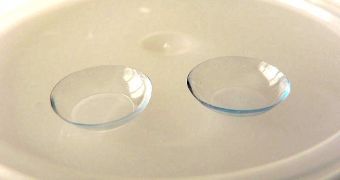Since they first appeared, at the end of the 19th century, contact lenses have brought forth a new age in treating diseases of the eye, eliminating the need for glasses, and hiding the handicap from prying eyes. Over the past decades, the production process related to these lenses has also evolved spectacularly, and even healthy people began wearing them, as fashion accessories, or for other uses than vision improvement. Now, with the advent of nanotechnology and advanced electronics, a new revolution in contact lenses may be at hand.
Scientists at the University of Washington in Seattle (UWS), led by Babak Parviz, recently came up with a new idea, to include minuscule electronics in new generations of the lenses, and thus create an entirely new type of Heads-Up Display (HUD), similar to the ones used on car windshields and airplane cockpits. The electric lens would function by harvesting radio frequencies from the environment for energy, and then transferring that power to a light-emitting diode (LED), embedded in the glass or plastic itself. The diode would then be used to project images directly into the eye of the wearer, without thus being visible from the outside.
“Our hope is to create images that effectively float in front of the user perhaps 50 centimeters to 1 meter away,” Parviz says of the team's efforts. The information to be displayed, the investigator says, could be emitted from a mobile device, such as a cell phone, smartphone or PDA. He adds that the idea came to him as he was working in embedding nanoscale and microscale electronic devices in paper and plastics, NewScientist reports. Parviz reveals that he wears contact lenses as well, and that, as such, the idea of combining the two just came naturally.
The new instrument requires about 330 microwatts to function, but does not require a battery to do its job. Parviz and his crew are currently investigating methods of using loop antennas to harvest the necessary power, perhaps even from the mobile device, as it transmits data to the LED on the lens. “A contact lens that allows virtual graphics to be seamlessly overlaid on the real world could provide a compelling augmented reality experience,” says the director of the Christchurch, New Zealand-based Human Interface Technology Laboratory, Mark Billinghurst, who was not involved with the research.

 14 DAY TRIAL //
14 DAY TRIAL //